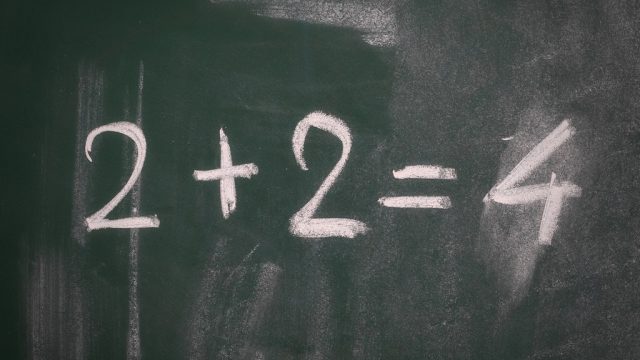Can You Solve This Simple Math Equation That’s Driving Everyone Crazy?

Every so often, a math problem goes viral on social media and leaves everyone who tries to solve it scratching their heads and wondering how they ever passed grade school.
This week, it was Twitter user @pjmdoll who had the world dumbfounded.
oomfies solve this pic.twitter.com/0RO5zTJjKk
— em ♥︎ (@pjmdolI) July 28, 2019
At first, the equation seems pretty easy. It’s hardly advanced calculus, after all. But then, you pause. Wait, what’s the order in which I’m supposed to solve this again?
A lot of people think that the answer is 1, thanks to PEMDAS, which dictates that you solve the equation within the parentheses first, then factor in exponents (not applicable here), followed by multiplication, division, addition, and subtraction. Which means that, in this case, it would be 2+2 equals 4, 4 multiplied by 2 equals 8, and 8 divided by 8 equals one.
(2+2) 4
8/2(4)
According to PEMDAS you need to get rid of parathenses first so
2(4)=8
8/8=1 answer is one.— koook (@SoWhAT9000) July 28, 2019
Simple, right? You don’t need to be an astronaut to figure it out.
i have 2 math degrees it’s 1
— laur♏️ (@lauram_williams) July 30, 2019
But not so fast.
Others are arguing that because multiplication and division are on the same level in PEMDAS, you’re supposed to solve the equation from left to right. Which means that once you do what’s inside the parentheses (which, yes, is still 4), you solve 8 divided by 2 (which equals 4), and 4 multiplied by 4, which indeed equals 16.
(2+2) = 4
8/2 = 4
4(4) = 16— em! (@jimnlvr) July 28, 2019
Is it 16? Is it 1? The debate got pretty wild.
IM SICK OF YALL pic.twitter.com/lCE1F1qg7b
— como siempre (@skylarrousse) July 30, 2019
Apparently, both answers are technically accurate because math is not as black and white as we once believed.
It’s either 1 or 16 depending on which mathematician you listen to, because order of operations isn’t a hard and fast rule, and math is really just a language.
And nothing is true. pic.twitter.com/d324s8grlA
— 🇳🇴Moon-faced Assassin of Joy🇺🇸 (@NomeDaBarbarian) July 30, 2019
Rhett Allain, an associate professor of physics at Southeastern Louisiana University, told Popular Mechanics that this equation “is the math version of, ‘What color is this dress? Blue and black or gold and white?’” He would personally go from left to right, thereby getting the answer 16, but that’s not a hard and fast rule.
“We have conventions on how to write these things just like we have conventions on how to spell stuff,” Allain said. “But still, there are different conventions. Some people spell it as ‘gray’ and others as ‘grey.’ We still understand what’s going on.”
Mike Breen, public awareness officer for the American Mathematical Society, similarly told Popular Mechanics that if you follow the “strict order of operations, you’d get 16,” but that he “wouldn’t hit someone on the wrist with a ruler if they said 1.”
“The way it’s written, it’s ambiguous,” Breen explained. “In math, a lot of times there are ambiguities.” And here we thought that math was the one thing we could depend on for absolute certainty.
Want to really test your math skills? Here are 20 Grade-School Math Questions So Hard You’ll Wonder How You Graduated.
To discover more amazing secrets about living your best life, click here to follow us on Instagram!